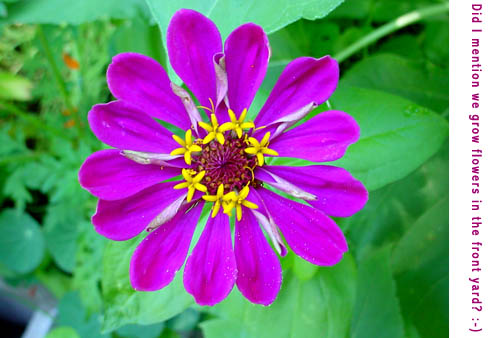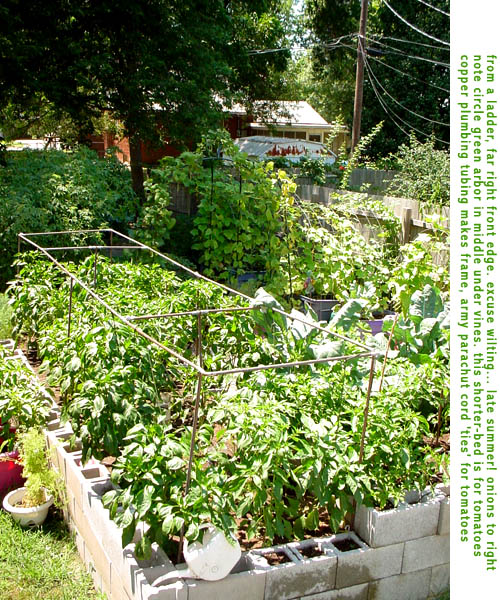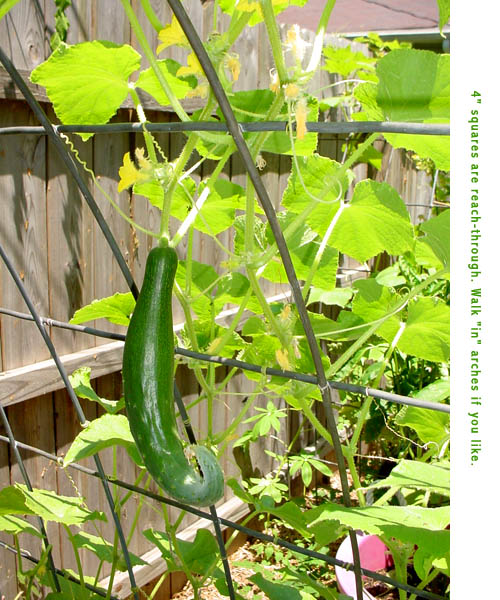Our various beds are different sizes. The two "big" beds are L-shaped, 32" high on the end parts, 24" high on the long parts, 4'8" wide everywhere, and about 185+ square feet of soil total.
The two "strawberry" beds are split in half depth-wise and are 16" and 24" high, around 4'x6' each, about 48 square feet of soil.
Having sacrificed six solid years of major strawberry gardening to get a total of 5 pitiful strawberries out of it total---we will not be growing strawberries this year. I'm sure we get good garden karma for feeding the birds, rolypoly bugs, ants, and squirrels, but I'd like to use the garden for something WE get to eat now...! Or at least pretty flowers! :-)

We have a dozen, 32 gallon rectangle "tub" planters (two for each arch and one at each side of the garden) that are about 24" high and 3 square feet of soil each. (36)
We have about ten, 22 gallon round "tub" containers around the yard; they are each about 24" high and each about 2.5 square feet of soil. (22)
There's also a wide variety of other tubs, pots and containers around the garden area and backyard depending on the season. Plus hanging and sitting pots on the front porch and side.
All told there is probably about 350 square foot of soil space in the garden. Which, since we do a lot of trellising, and a square foot approach, means we can have a LOT of volume.

I also have little flower beds in both back and front yard that are only 8" high and vary in size. All but the little flower beds are in 1/3 of my backyard, on a space laid out with wood-chip mulch, so it's a nice little environment to garden in, and you can reach everything.

The "garden props" aside from the cinderblock beds are:
1. Five 'cattle panels' bent in arches along the 6' wooden fence at the side. These panels themselves are four foot wide, 14 foot long, and they have a four inch "square grid" pattern, which is perfect for 'reaching through'. I bend them into arches which are 6 foot high and about 4 foot wide and 4 foot deep. You can walk inside them and pick stuff from inside, or from the outside.
They use 32 gallon dollar-store tubs as planters at the bottom of each side. I was told the freezing would crack the rubber-plastic but you know... it's been a few years and it hasn't happened. Get the cheap huge tubs of varying size from the dollar store, take a drill and put some holes in the bottom for drainage, and you have a good sized planter. I'm pretty sure the 32s ar storage tubs (they had lids). I also have some 22 gallon size that I think are squat laundry baskets, as they are round with rope handles on each side. Some plastic bottles from the trash and a couple dollar store big tubs and you can have a cool little container garden -- and using the "square foot" approach you can plant a lot more in that than the old-fashioned row-gardening might make ya think!
It's important in the summer to water planters more than you can imagine is needed, they dry out fast. If you don't have automated irrigation (I hope to get some!), this is really the best idea: get 2 litre plastic bottles or something similar, slice off the bottom. Bury it in the soil open-spout down. Each time you water, 'fill up' the containers with your hose. The water will drain into the soil at the rate it can absorb. It's not a mosquito issue because the water won't sit long enough for breeding. And in the summer when it's insanely hot, the plants really need water, and unless you plan on watering them four times a day, they won't get enough in this kind of garden -- these beds are not open to the ground, they are essentially really big containers.


2. A six foot diameter, ten foot tall, metal green arbor in the center of the garden. In the middle are various pots but I think this season we will put our birdbath in the middle! That would be lovely. Next to each of the three supports are small tub planters that grow stuff that trellises up the arbor. This thing is so beautiful! We gotta get a better pic of it. Despite all the warnings from people about a billion weed seedlings in veggie beds, we may vine morning glories or other viney-flowers up it. Maybe those snail-flower fragrant vines that are getting so popular, as they are such a long vine, they could almost reach the ground on the other side.
3. Copper tubing (1.25" hollow plumber's tubing) frames the 'big' bed on the right side, only the 'long' portion of it. Army parachute cord (thick, slightly stretchy, never biodegrades, essentially indestructible except by knife) is what we use as the ties. We use the copper framing and ties, some anchored to stakes in the soil, for the tomato plants that grow in that section. We get very high straight-line winds in NE Oklahoma, and sometimes hail and major downpours, so every tomato plant has to have decent anchor or the first major storm would wipe out the crop. The pepper plants on the other hand are difficult to kill. Except occasionally by critters like rabbits and turtles (the high beds at least minimize those!).
See the pic above under the "beds" info for the copper framing and round arbor pic.
4. We have a 16 foot long, 8 foot high, 4 foot wide "grapevine arbor" made of 2x4s (some treated, some not) and chicken coop fencing. Ugly (we didn't build it! we are innocent!), but workable. We just planted this a year ago, 1 year vines, so we will not see a crop for another year or two. We have about 8 different varieties, seedless and regular, a variety of colors.

Outside of the garden beds and props we also have a few "thornless blackberry" bushes we just put in a year ago.
January is WINTER SOWING! This is for the seed-starting equivalent of 'compost whackos' -- people who, just as the weather hits sub-freezing, just as you are as far from any garden season as humanly possible, ya suddenly get obsessed with gardening! You just can't wait! You can't stand it! Winter Sowing is all about starting lots of seeds outdoors during winter, so that come spring you have lots of seedlings that, while small, are already "hardened off" and used to the weather.
.
1 comment:
Hi! This is Plot_Thickens from GW. Could you tell me more about your arches for squash? We're planning something like that and we'd love to learn from you. I'm at arissssss at yahoo (dot) c o m .
Post a Comment